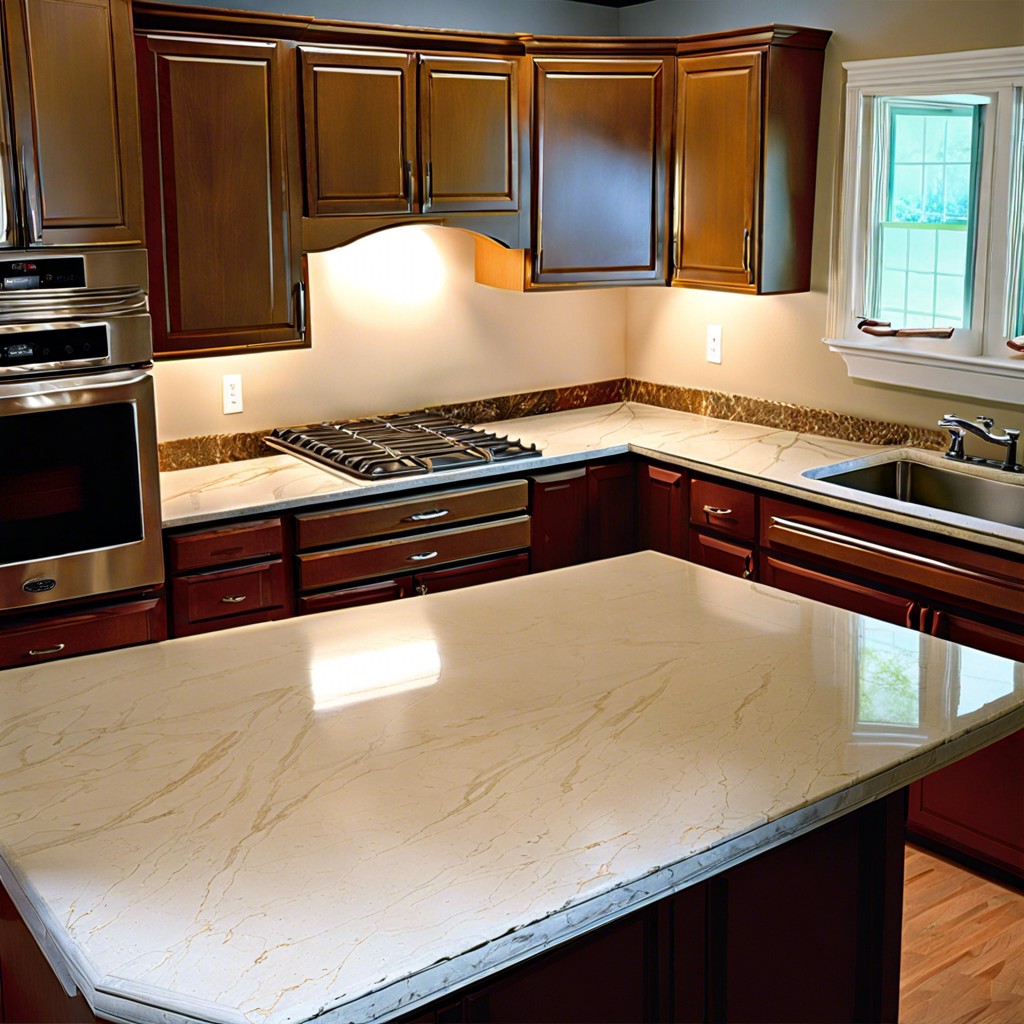Last updated on
Learn how to replace your countertops with this step-by-step guide, covering everything from material selection to installation tricks.
Key takeaways:
- Evaluate the condition of your kitchen before replacing countertops
- Measure accurately for a proper fit
- Choose countertop materials that complement your kitchen’s style
- Consider the cost of materials, labor, and long-term maintenance
- Plan the countertop replacement to align with other renovations
What's Inside
Before Replacing Kitchen Countertops

Embarking on a countertop replacement adventure? Hold your horses! First, evaluate the current state of your kitchen. Are your foundations solid as a rock, or do they wobble like a table at a cheap cafe? Sturdy cabinets can support the weight of new countertops; otherwise, you’re looking at additional repairs or reinforcement, which can add to the budget.
Remember, patience is a virtue, especially with demolition. Carefully removing old countertops prevents damage to the walls and cabinets that are sticking around. It’s not just about brawn here; a gentle touch is golden. Plus, think of the treasures you might find behind that old tile—hello, long-lost spatula!
Now, let’s talk guts—or rather, what’s behind those walls. Plumbing and electrical work are like the secret sauce in a gourmet dish; you don’t see them, but boy, do they make a difference. Make sure they’re in tip-top shape or ready to be updated to meet the requirements of new appliances and fixtures that will accompany your countertop.
Measure twice, cut once—isn’t that what they say? Precision here is key. Ensure accurate measurements because an inch off could mean the difference between a snug fit and a countertop that just won’t sit right. Like a bad haircut, it’s immediately noticeable and might irk you every time you walk into the kitchen.
Lastly, play the matchmaker. Your countertops should complement the kitchen’s style and play nice with the flooring, cabinetry, and backsplash. It’s not about finding the flashiest materials but creating a harmony that feels right at home. And remember, trends come and go, but timeless design is a feast for the eyes forever.
Installation Preparation
Getting your space ready before the new countertops arrive is like setting the stage for a star performer. First, clear the decks – remove any appliances, kitchen tools, and decorations. You’re aiming for a blank canvas. Next, assess the old countertops and cabinets for any damage. Repairs now can prevent headaches later. Make sure to shut off the water supply before removing the sink to steer clear of an impromptu indoor fountain.
Give a thought to the path workers will take to bring in the new countertops. Remove any trip hazards and ensure there’s ample room for maneuver. This detail isn’t minor – it’s like planning a parade route, you need a clear path to avoid chaos. Lastly, if your new countertops require new appliances or fixtures, have them on hand. Delaying could be like putting the cart before the horse, affecting the entire installation timeline.
Kitchen Countertop Materials
When the time comes to pick out a new stage for your cooking performances, you’ll be met with a smorgasbord of material choices, each with its own flavor of pros and cons.
Granite has long been the go-to charmer in kitchens, sought after for its soli`d reputation and rich, natural veining that makes each slab a snowflake in its own right. However, keep in mind that it needs regular sealing to fend off stains.
Quartz, on the other hand, is the low-maintenance cousin in the stone family, offering a banquet of colors and patterns sans the fuss of sealing. The durability of this engineered stone can withstand the hustle and bustle of a dynamic kitchen.
If you want to steer into the lane of modernity, consider stainless steel. Making your kitchen look like a chef’s paradise, it steels the spotlight by serving both sustainability and ease of cleaning on a silver platter.
Laminate is a budget enchanter that mimics the look of luxury without breaking the bank. It’s like a culinary chameleon, with a learning curve so flat, you might just think you’re dealing with something pricier.
For those with green garnishes in mind, butcher block infuses warmth and is a renewable resource to boot. Treat it well with regular oiling, and it’ll be chopping-block ready for all your dicing dances.
Don’t forget concrete – the gritty contender rising in popularity for those who want an industrial edge. Customizable in various finishes, it can be an understudy for more expensive materials, offering a robust look without the stage fright of scratches.
Each material has its own recipe of benefits and maintenance needs, so choose the one that’ll perfectly complement the taste of your kitchen’s aesthetic and functional needs.
Cost
Budget often takes center stage in any kitchen remodel. The price tag on new countertops can vary dramatically, hinging on the material you choose, the complexity of the installation, and the countertop’s size.
Laminates tend to be the wallet-friendly choice, giving you a bang for your buck without skimping on color and style options. If you’ve got a bit more to spend, granite and quartz offer that wow factor and a solid return on investment due to their durability and resistance to wear and tear.
Don’t forget to factor in the cost of labor, which can sometimes equal or even surpass the cost of the materials themselves. Extra features like fancy edges or backsplashes also add to the bottom line.
Finally, consider the long-term costs. Some options might have a higher upfront cost but lower long-term maintenance. Others might be cheaper now but require more care and repairs over time. The trick is to balance your upfront budget with future expenses to find a comfortable middle ground for your wallet.
Considerations When Replacing Kitchen Countertops
Picking the right time for a countertop makeover is like waiting for the ripe moment to pluck a fruit – you want everything to be just perfect. Begin with a bird’s-eye view of your daily kitchen hustle. High traffic during holiday seasons? Maybe it’s best to avoid those times.
Alignment with other renovations is a savvy move. If you’re already painting cabinets or upgrading appliances, synergize these projects. Why tear up the kitchen twice when you can coalesce tasks and create less disruption?
When your heart says marble but your wallet whispers laminate, strike a balance. Cost efficiency isn’t just about the price tag—it’s the marriage of durability, maintenance, and aesthetic appeal. Weigh these factors to find a love match for your lifestyle.
Consider the long haul. Visualizing your kitchen in the future can prevent the ‘I wish I had thought of that’ syndrome. If selling is on the horizon, consider neutral hues that woo a wide array of buyers. Personalize, but don’t pigeonhole your space with too bold a statement that might only sing your tune.
The installation saga doesn’t end with just picking materials. Assess the muscle behind the magic. Experienced pros can mean the difference between countertops that stand the test of time and those that start waving the white flag too early.
Lastly, let’s talk about the aftermath. Swapping countertops often unveils the unexpected—like outdated wiring or plumbing that’s seen better days. Set aside a cushion for these surprise guests so they don’t crash your budget party uninvited.





